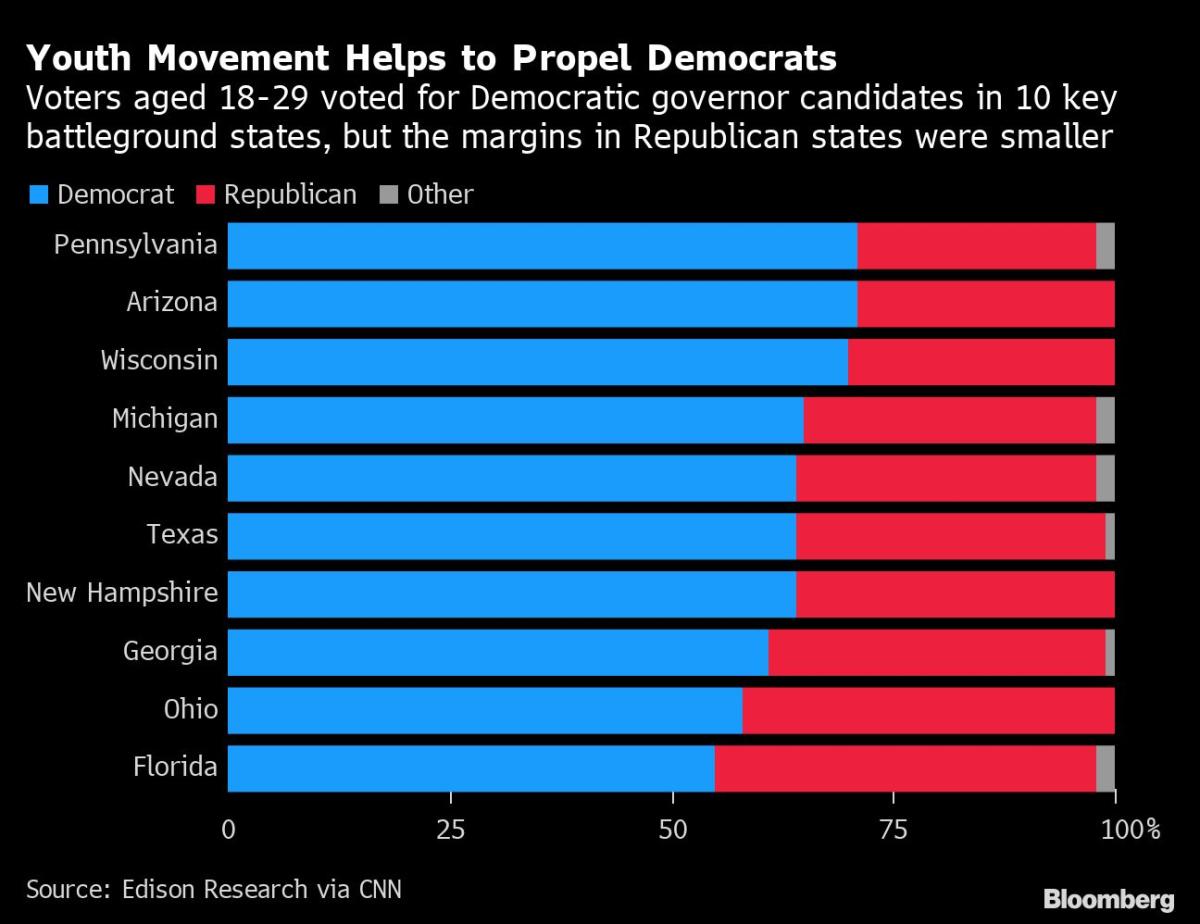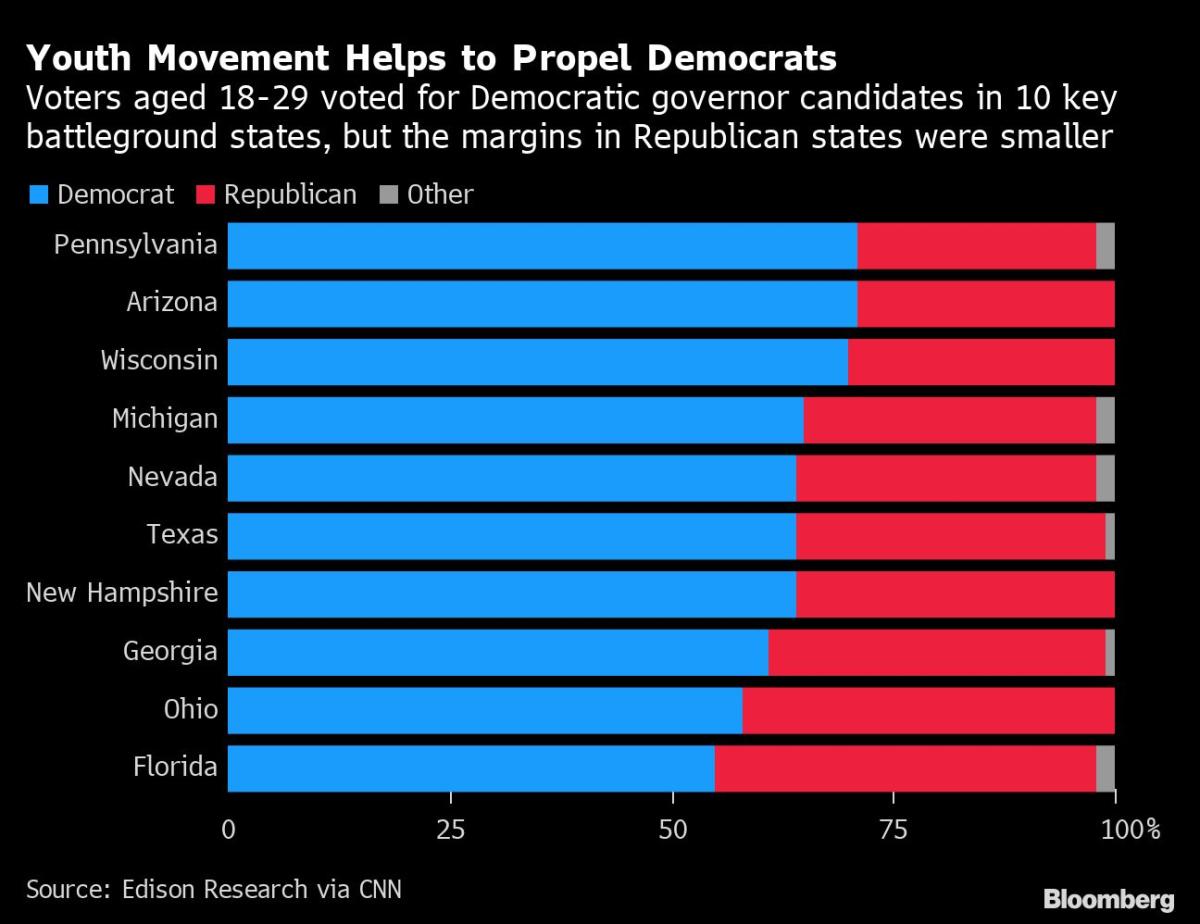
(Bloomberg) — Young voters delivered on President Joe Biden’s hopes they would turn out in the midterms, helping to win key Senate races and fending off a Republican bid to wrest full control of Congress.
Most Read from Bloomberg
Voters under 30 were decisive in Democratic Senator Catherine Cortez Masto’s win in Nevada — which officially secured the party’s hold on the chamber. And Democratic Senator Raphael Warnock might not have been able to force a December runoff against Republican challenger Herschel Walker without them.
Outsized support from young voters helped carry Democrats to victory in the Pennsylvania and Arizona Senate contests, according to data analyzed by Tufts University’s Center for Information & Research on Civic Learning and Engagement.
Twenty-seven percent of voters aged 18 to 29 cast ballots in last week’s elections, the second-highest turnout in three decades, according to the analysis. The participation was surpassed only by the 31% who voted in the 2018 midterms under former President Donald Trump.
Signs show the bloc increasingly trending away from the GOP. Network exit polls found young voters broke widely for Democrats, by 63% to 35% in House races, and by an even more pronounced split in crucial Senate contests, including Pennsylvania, where they favored Democrat John Fetterman by 70% to 28%, a 42-point margin over Republican challenger Mehmet Oz.
Political watchers have often downplayed the impact of under 30-year-olds in midterms, arguing they fail to turn out. But this year, according to data from the Tufts center, known as CIRCLE, they were instrumental in the Georgia Senate race, delivering 116,000 net votes to Warnock, who garnered just 35,000 votes more than Walker. The final outstanding Senate race is set to be decided in a Dec. 6 runoff, in which enthusiasm from young people could be pivotal.
In other Senate races, the final margin of victory was larger than the youth contribution, but the disparity in votes for Democrats over Republicans still factored heavily in Biden’s party retaining control of the chamber.
“Young voters were the difference between a Republican-controlled or Democratic-controlled Senate,” said John Della Volpe, director of polling at the Harvard Kennedy School Institute of Politics.
Edge in Close Races
Cortez Masto’s razor-thin, 49% to 48%, defeat of Republican Adam Laxalt is attributable to young voters, according to CIRCLE’s data, which found those under 30 backed Cortez-Masto 64% to 31%, accounting for 11% of votes cast.
In Arizona, incumbent Senator Mark Kelly carried the youth vote by 76% to 20%, boosting him to a 51% to 47% victory over Republican challenger Blake Masters.
But in Ohio, Florida and North Carolina — three Senate races where Republicans were victorious — young voters broke for Democrats by smaller margins. The bloc was not enough to propel Democrat Mandela Barnes across the finish line in Wisconsin, where Republican Senator Ron Johnson squeaked by 50.5% to 49.5% despite losing under 30s by 69% to 31%.
The past three election cycles — 2018, 2020 and 2022 — broke a pattern of nearly split political allegiances among younger Americans, which once tended to favor Republicans in midterm years, according to Kei Kawashima-Ginsberg, director of CIRCLE.
Biden credited those voters in a press conference the day after the election.
“I especially want to thank the young people of this nation, who — I’m told, I haven’t seen the numbers — voted in historic numbers again — just as they did two years ago,” he said.
Play for Youth Vote
Pollsters projected Democrats would suffer losses driven by high inflation and worries about a potential recession. But exit polls show social issues such as abortion were equally important for voters who — in addition to keeping Democrats in control of the Senate — left Republicans with a smaller-than-expected majority in the House.
In April, Della Volpe and student leaders from the Harvard Public Opinion Project briefed Biden and White House staffers on the youth vote, according to Alan Zhang, the project’s student chair. They shared findings from their Spring 2022 poll, conducted in March, which showed Biden’s approval down 18 points among young people since taking office.
Biden and Democrats made a play for young and non-White voters in the subsequent months with initiatives to forgive as much as $20,000 in student debt and pardons for Americans with federal convictions for marijuana possession. Biden in speeches also hit at the US Supreme Court decision overturning nationwide abortion rights and the emphasized threat he said Trump supporters posed to democratic institutions.
Earlier: Biden’s Pot Pardons Light Up Voters Democrats Need to Turn Out
While polls show broad support for student debt relief and easing of cannabis prosecutions, it is unclear how much those moves motivated voters.
An October poll by Harvard’s Institute of Politics of likely voters under 30 found that 54% said Biden’s student-debt forgiveness plan would be good for the country, but only 9% said it was an important issue, well behind inflation at 45%, abortion at 33%, and “protecting democracy” at 30%.
Separately, an October Politico and Morning Consult survey found 71% of millennials and 55% of Gen Z voters supported Biden’s cannabis pardons.
Kawashima-Ginsberg of CIRCLE said the president’s ability to deliver on some campaign promises boosted him with that demographic.
“The student debt cancellation certainly affirmed many people’s faith in the Biden administration,” she said.
Nathan Brand, a Republican National Committee spokesperson, said the GOP overperformed with young people in certain states compared to previous cycles.
“Democrats’ policies and empty promises have made life more expensive and more difficult to buy a home, and young people are more pessimistic about the direction of our country,” Brand said.
Florida was one bright spot for Republicans, where the party won both a gubernatorial and Senate contest. Exit polls show Democrats had only a slim edge in the vote for governor, in which potential 2024 presidential candidate Ron DeSantis handily beat his Democratic challenger.
Overall, the results should be alarming for Republicans — whose largest share of voter support comes from the Silent Generation, baby boomers and Gen Xers, according to Della Volpe, who warned the GOP could become “a regional party.”
“Younger voters — Gen Z and millennials — will represent 40% of the electorate in the next presidential election,” he said. “You don’t need to be a statistician to see that’s not sustainable.”
–With assistance from Zahra Hirji.
Most Read from Bloomberg Businessweek
©2022 Bloomberg L.P.




